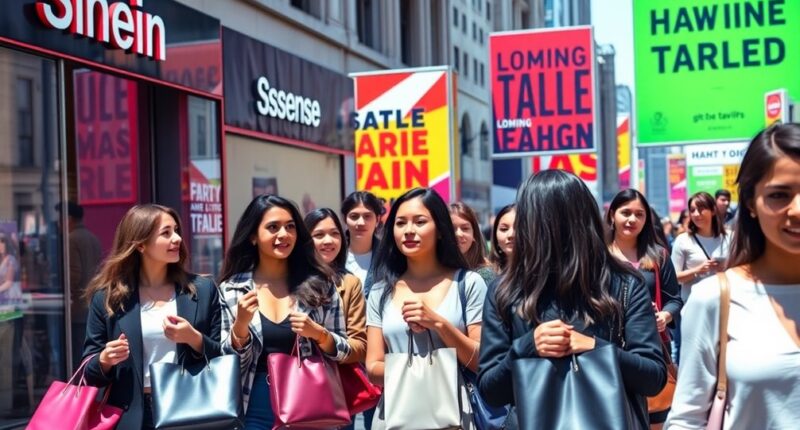Shein and Ssense shoppers are feeling the heat as rising import tariffs threaten to impact fashion choices and budgets. Starting May 2, 2024, the removal of the duty-free exemption means you’ll be paying higher prices on trendy items. With tariffs potentially reaching 30% or $25 per item, shopping habits may need to change. As costs rise, you might find yourself reconsidering where to spend your money. Discover how these changes could reshape your shopping experience.
Key Takeaways
- Shein and Temu shoppers face rising prices as tariffs on imported fast fashion items increase significantly after the removal of the de minimis exemption.
- U.S. households could see budget increases of up to $2,100 due to these new import tariffs, straining finances.
- Increased costs may shift consumer preferences towards domestic brands, benefiting retailers like Forever 21 over foreign fast fashion companies.
- High-end retailers like Ssense may experience indirect effects from tariffs, prompting changes in pricing strategies to maintain competitiveness.
- Shoppers must stay informed about tariff impacts and adjust budgets and shopping habits in response to the evolving retail landscape.

As tariffs on imported goods loom large, Shein and Ssense shoppers may soon feel the pinch in their wallets. The removal of the “de minimis” exemption, which allowed shipments under $800 to enter the U.S. duty-free, is set to end on May 2. This change will hit Shein and Temu hard, with tariffs potentially reaching up to 30% or $25 per item. You can expect to see rising prices on your favorite fast fashion items, which could strain your budget significantly.
With the introduction of these tariffs, U.S. households might face budget increases of up to $2,100 due to the overall impact on various imports. The de minimis exemption has significantly increased the number of shipments, with 1.36 billion utilizing it in 2024. The Chinese Ministry of Commerce has already warned that these tariffs could jeopardize global economic growth. While U.S. businesses may benefit from a more level playing field, you’ll likely notice that your shopping expenses rise, pushing you to rethink your fashion choices.
Competition in the retail market could shift as fast fashion retailers like Shein and Temu struggle with increased costs. Brands like Forever 21 might gain an advantage as they can offer more competitive pricing without the heavy tariffs that foreign brands will face. This could lead to a change in consumer behavior, with shoppers opting for domestic brands over international ones as prices rise.
For Ssense shoppers, the impact of tariffs isn’t as clear-cut. While high-end brands typically have different market dynamics, they’ll still likely feel the ripple effects of increased costs. Retailers may need to adjust their pricing strategies to remain competitive, and even luxury brands may see shifts in consumer loyalty based on perceived value.
Ultimately, as prices climb, you’ll want to stay informed about how these tariffs shape your shopping experience and consider new strategies to navigate the changing landscape. Your wallet could soon dictate a different shopping routine.
Frequently Asked Questions
How Do Tariffs Affect Online Shopping Prices?
Tariffs can significantly impact online shopping prices. When tariffs increase, retailers often pass those costs onto you, leading to higher prices on clothing, electronics, and other goods.
You might notice specific items becoming more expensive, with estimates suggesting rises of up to 17% for clothing. Additionally, retailers may adjust their shipping methods or sourcing strategies, which can further influence the prices you see online.
What Is the History of Tariffs on Fashion Imports?
You might think tariffs are a modern issue, but their history in fashion goes back centuries.
In the 1890s, high tariffs on silk and luxury goods impacted elite consumers reliant on imports. These policies sparked debates over economic protectionism and social class.
Fast forward to today, and tariffs still influence pricing and sourcing strategies in the fashion industry, shaping how brands approach production and ultimately affecting what you pay as a shopper.
Are There Alternatives to Shein and Ssense?
If you’re looking for alternatives to Shein and SSENSE, you’ve got plenty of options.
Consider sustainable brands like Whimsy + Row or The Common Good Company for eco-friendly fashion.
For luxury, try 24S or Moda Operandi, which offer exclusive pieces.
You might also explore independent brands for unique styles.
Retailers like Zara and Mango provide stylish options while maintaining brand recognition.
Each of these choices offers quality and variety to suit your fashion needs.
How Can Shoppers Prepare for Rising Costs?
As the tides of retail shift, you might feel the waves of rising costs crashing at your doorstep.
To prepare, start by tightening your budget, setting aside extra funds for those inevitable price hikes.
Explore alternative brands that aren’t as affected by tariffs, and consider bulk buying to save in the long run.
Keep an eye out for sales on items already stocked in warehouses, helping you navigate the storm with a savvy shopping strategy.
What Are the Implications for Small Fashion Businesses?
Small fashion businesses face significant challenges due to rising tariffs.
You’ll likely see increased production costs, forcing brands to adjust their pricing strategies. This could squeeze your favorite small brands, as they struggle with limited resources and bargaining power.
Additionally, the need to diversify suppliers may lead to costly transitions, impacting their ability to compete.
Ultimately, you might notice fewer options and higher prices, as these businesses navigate an increasingly difficult market landscape.
Conclusion
So, as you scramble to grab those trendy finds from Shein and Ssense, it’s almost amusing how Trump’s tariffs might just turn your shopping spree into a high-stakes game of price roulette. Who knew that fashion could come with a side of politics? As you check out, you might want to ask yourself: are those cute outfits still worth it, or are you just dressing for a potential financial disaster? Either way, happy shopping—just don’t forget your wallet!









